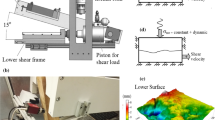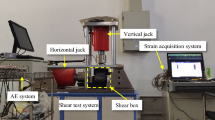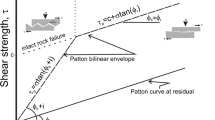Abstract
Quantifying the changes of frictional strength during dynamic normal loading is significant for investigations of joint and fault interaction as well as earthquake triggering. The frictional character of a natural basalt rock fracture with a rough surface is investigated by conducting well-controlled, repeatable direct shear experiments using a large-scale dynamic shear box equipment. Normal force oscillations, simulating a dynamic normal force, are applied to the fractured basalt sample. Simultaneously, a shear force acts on the lower block of the sample which provides a constant slip rate. The frictional behavior is investigated by applying a normal load with oscillation amplitude from 0 up to 80% of the initial normal load. Experimental results showed that the dynamic disturbance decreases the friction of the rock fracture, the minimum friction reduces with rising normal load oscillation amplitude. The dynamic disturbance enhances the maximum shear force under the smaller normal load oscillation amplitude. When the normal load oscillation amplitude exceeds a critical point, the maximum shear force reduces, even reaching “negative” values. Moreover, a phase difference (D1) is identified between peak normal load and peak shear load with peak normal load leading. There is also a phase difference (D2) between peak normal load and peak apparent dynamic friction coefficient. The phase difference of D1 rises with rising normal load oscillation amplitude, decreases with shearing, while, relative phase lag of D2 keeps constant. Our results confirm that dynamic normal force can both enhance and reduce the stability of a steadily slipping fracture depending on the normal force oscillation amplitude.
Highlights
-
Dynamic normal load can both enhance and reduce the stability of the steadily creeping faults dependent on the normal load oscillation amplitude.
-
A critical normal load oscillation amplitude is confirmed to judge the frictional strengthening or frictional weakening of the creeping rock fracture.
-
A time difference between peak normal force and peak shear force with normal force ahead is confirmed.









Similar content being viewed by others
Abbreviations
- A :
-
Normal load oscillation amplitude
- A * :
-
Critical normal load oscillation amplitude
- F sd :
-
Dynamic normal load
- F N :
-
Initial normal load
- f :
-
Normal load oscillation frequency
- t :
-
Time
- F s :
-
Shear force
- ΔF s1 ΔF s2 :
-
Variation of shear force
- Δμ d1 Δμ d2 :
-
Variation of dynamic coefficient of friction
- Δd 1 Δd 2 :
-
Variation of vertical displacement
- μ ss :
-
Initial friction coefficient
- μ d :
-
Dynamic friction coefficient
- μ dmax :
-
Maximum value of dynamic friction coefficient in a cycle
- μ dmin :
-
Minimum value of dynamic friction coefficient in a cycle
- D1 :
-
Time difference between normal stress and shear stress
- D2 :
-
Time difference between normal stress and apparent friction coefficient
- D3 :
-
Time difference between normal stress and vertical displacement
- E :
-
Energy consumption
- Ɛ:
-
Normalized normal load oscillation amplitude, i.e., A/FN
- u :
-
Slip length
- u max :
-
Maximum slip length
- v :
-
Slip rate
- Z i :
-
Asperity height
- n :
-
Number
- Δ x :
-
Interval of data points
References
Aboudi J, Ryvkin M (2014) Dynamic overshooting in 2D periodic materials with square voids caused by sudden flaw appearance. Int J Solids Struct 51(13):2345–2359
Aiken C, Meng X, Hardebeck J (2018) Testing for the ‘predictability’ of dynamically triggered earthquakes in the geysers geothermal field. Earth Planet Sci Lett 486:129–140
Barton NR, Choubey V (1977) The shear strength of rock joints in theory and practice. Rock Mech 10(1–2):1–54
Beeler NM, McLaskey GC, Lockner D, Kilgore B (2019) Near-fault velocity spectra from laboratory failures and their relation to natural ground motion. J Geophys Res: Solid Earth 125(B2):e2019JB017638
Boettcher MS, Marone C (2004) Effects of normal stress variation on the strength and stability of creeping faults. J Geophys Res: Solid Earth 109(B3):B03406
Bureau L, Baumberger T, Caroli C (2000) Shear response of a frictional interface to a normal load modulation. Phys Rev E 62(5):6810–6820
Candela T, Brodsky EE, Marone C, Elsworth D (2014) Laboratory evidence for particle mobilization as a mechanism for permeability enhancement via dynamic stressing. Earth Planet Sci Lett 392:279–291
Cochard A, Rice JR (2000) Fault rupture between dissimilar materials: ill-posedness, regularization, and slip-pulse response. J Geophys Res: Solid Earth 105(B11):25891–25907
Cochard A, Bureau L, Baumberger T (2003) Stabilization of frictional sliding by normal load vibrations. J Appl Mech 70:220–226
Dang W, Konietzky H, Frühwirt T (2016) Shear behaviour of a plane joint under dynamic normal load (DNL) conditions. Eng Geol 213:133–141
Dang W, Konietzky H, Frühwirt T (2017) Direct shear behavior of planar joints under cyclic normal load conditions: effect of different cyclic normal force amplitudes. Rock Mech Rock Eng 50(4):1–7
Dang W, Konietzky H, Chang L, Frühwirt T (2018) Velocity-frequency-amplitude-dependent frictional resistance of planar joints under dynamic normal load (DNL) conditions. Tunn Undergr Space Technol 79:27–34
Dang W, Konietzky H, Frühwirt T, Herbst M (2020) Cyclic frictional responses of planar joints under cyclic normal load conditions: laboratory tests and numerical simulations. Rock Mech Rock Eng 53:337–364
Dang W, Chen J, Huang L (2021) Experimental study on the velocity-dependent frictional resistance of a rough rock fracture exposed to normal load vibrations. Acta Geotech 16(7):2189–2202
Dang W, Wu W, Konietzky H, Qian J (2019) Effect of shear-induced aperture evolution on fluid flow in rock fractures. Comput Geotech 114:103152
Gong F, Luo S, Lin G (2020) Evaluation of shear strength parameters of rocks by preset angle shear, direct shear and triaxial compression tests. Rock Mech Rock Eng 53:2505–2519
Gong F, Wang Y, Wang Z (2021) A new criterion of coal burst proneness based on the residual elastic energy index. Int J Min Sci Technol 31(4):553–563
Goodman RE (1976) Methods of geological engineering in discontinuous rocks. Int J Rock Mech Min Sci Geomech Abstr 13(10):155
Greenwood JA, Williamson JBP (1966) Contact of nominally flat surfaces. Proc R Soc A 295:300–319
Hobbs BE, Brady BHG (1985) Normal stress changes and the constitutive law for rock friction (abstract). Eos Trans AGU 66:385
Hong T, Marone C (2005) Effects of normal stress perturbations on the frictional properties of simulated faults. Geochem Geophys Geosyst 6:Q03012
Ji Y, Zhuang L, Wu W, Hofmann H, Zang A, Zimmermann G (2021) Cyclic water injection potentially mitigates seismic risks by promoting slow and stable slip of a natural fracture in granite. Rock Mech Rock Eng 54(10):5389–5405
Julian BR (2000) Period doubling and other nonlinear phenomena in volcanic earthquakes and tremor. J Volcanol Geotherm Res 101(1):19–26
Kilgore B, Lozos J, Beeler N, Oglesby D (2012) Laboratory observations of fault strength in response to changes in normal stress. J Appl Mech 79(3):031007
Kilgore B, Beeler NM, Lozos J, Oglesby D (2017) Rock friction under variable normal stress. J Geophys Res: Solid Earth 122(9):7042–7075
Konietzky H, Frühwirt T, Luge H (2012) A new large dynamic rockmechanical direct shear box device. Rock Mech Rock Eng 45(3):427–432
Li Y, Wu W, Wei X (2020) Analytical modeling of the shear behavior of rock joints with two-order asperity dilation and degradation. Int J Geomech 20(6):04020062
Linker MF, Dieterich JH (1992) Effects of variable normal stress on rock friction: observations and constitutive equations. J Geophys Res 97:4923–4940
Marone C (1998) Laboratory-derived friction laws and their application to seismic faulting. Annu Rev Earth Planet Sci 26(1):643–696
Mei C, Barbot S, Wu W (2021) Period-multiplying cycles at the transition between stick-slip and stable sliding and implications for the Parkfield period-doubling tremors. Geophys Res Lett 48:e2020GL091807
Meng F, Wong NYL, Zhou H, Wang Z (2018) Comparative study on dynamic shear behavior and failure mechanism of two types of granite joint. Eng Geol 245:356–369
Mighani S, Bernabé Y, Boulenouar A, Mok U, Evans B (2019) Creep deformation in Vaca Muerta shale from nanoindentation to triaxial experiments. J Geophys Res: Solid Earth 124(8):7842–7868
Molinari A, Perfettini H (2017) A micromechanical model of rate and state friction: 2. effect of shear and normal stress changes. J Geophys Res: Solid Earth 122(4):2638–2652
Olsson WA (1988) The effects of normal stress history on rock friction, key questions in rock mechanics. In: Proceedings of the 29th U.S. Symposium, Univ. of Minnesota, Balkema, pp. 111–117.
Perfettini H, Schmittbuhl J, Rice JR, Cocco M (2001) Frictional response induced by time dependent fluctuations of the normal loading. J Geophys Res: Solid Earth 106:455–472
Prakash V (1998) Frictional response of sliding interfaces subjected to time varying normal pressures. J Tribol 120:97–102
Rice JR (2006) Heating and weakening of faults during earthquake slip. J Geophys Res: Solid Earth 111:B05311
Rice JR, Lapusta N, Ranjith K (2001) Rate and state dependent friction and the stability of sliding between elastically deformable solids. J Mech Phys Solids 49(9):1865–1898
Ruina AL (1983) Slip instability and state variable friction laws. J Geophys Res: Solid Earth 88:10359–10370
Sheng M, Li P, Zhuang XY, Wang JB (2020) Influence of cyclic normal stress on shear friction of EGS granite fractures. Eng Fract Mech 238:107268
Smith SAF, Nielsen S, Toro GD (2015) Strain localization and the onset of dynamic weakening in calcite fault gouge. Earth Planet Sci Lett 413(4):25–36
Stein RS (1999) The role of stress transfer in earthquake occurrence. Nature 402:605–609
Tse R, Cruden DM (1979) Estimating joint roughness coefficients. J Rock Mech Min Sci Geomech Abstr 16(5):303–307
Webber S, Ellis S, Åke F (2018) “Virtual shear box” experiments of stress and slip cycling within a subduction interface mélange. Earth Planet Sci Lett 488:27–35
Wei M, Kaneko Y, Liu Y, Mcguire JJ (2013) Episodic fault creep events in California controlled by shallow frictional heterogeneity. Nat Geosci 6:1–5
Wei M, Liu Y, Kaneko Y, Mcguire JJ, Bilham R (2015) Dynamic triggering of creep events in the Salton Trough, Southern California by regional M≥5.4 earthquakes constrained by geodetic observations and numerical simulations. Earth Planet Sci Lett 427(1):1–10
Xie HP, Zhu JB, Zhou T, Zhao J (2021) Novel three-dimensional rock dynamic tests using the true triaxial electromagnetic hopkinson bar system. Rock Mech Rock Eng 54(4):2079–2086
Zhang G (2020) PhD Thesis: Cerchar abrasivity tests: Laboratory tests and numerical simulations. TU Bergakademie Freberg
Zhou T, Zhu JB, Xie HP (2020) Mechanical and volumetric fracturing behaviour of three-dimensional printing rock-like samples under dynamic loading. Rock Mech Rock Eng 53(6):2855–2864
Acknowledgements
This work was supported by the National Natural Science Foundation of China (51904359, 51978677, 52111530089), the Natural Science Foundation of Guangdong Province of China (2020A151501528), the Guangdong Provincial Department of Science and Technology (Grant No. 2019ZT08G090), the Enhanced National Key Basic Research Program (2019-JCJQ-ZD-352-00-04) and Science and Technology Program for Sustainable Development of Shenzhen (KCXFZ202002011008532). Special thanks to Dr. Thomas Frühwirt, who helped to generate the dynamic signals, Mr. Tom Weichmann, who helped to operate the shear box device, and Mr. Gerd Münzberger, who helped to install the samples during laboratory testing. The laboratory test data can be download at https://doi.org/10.6084/m9.figshare.12403538.v1.
Author information
Authors and Affiliations
Corresponding author
Ethics declarations
Conflict of interest
The authors declare that they have no conflicts of interest to this work.
Additional information
Publisher's Note
Springer Nature remains neutral with regard to jurisdictional claims in published maps and institutional affiliations.
Rights and permissions
About this article
Cite this article
Dang, W., Konietzky, H. The Effect of Normal Load Oscillation Amplitude on the Frictional Behavior of a Rough Basalt Fracture. Rock Mech Rock Eng 55, 3385–3397 (2022). https://doi.org/10.1007/s00603-022-02815-w
Received:
Accepted:
Published:
Issue Date:
DOI: https://doi.org/10.1007/s00603-022-02815-w




